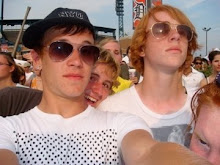 Detective Comics #27 is monumentally important, but that doesn't mean it has aged well. The cover promises the "amazing and unique" adventures of "The Bat-Man," but there is little unique here, as the caped crusader just kind of follows Commissioner Gordon around as the police track a series of murders. He has all of four lines while in costume, including one where he brushes off the horrific, acid bath death of a criminal like it's no big thing. There have certainly been many narrative changes since 1939, but we've read other material from the era (namely, The Spirit) that really uses the medium to the fullest. Detective Comics really uses the art to illustrate a sparse prose story, allowing the visuals to carry almost none of the story alone. I'm extremely appreciative that this character did catch on and open up the doors to some of the greatest stories ever told, but here I see so little of what has given Batman (no hyphen!) his lasting appeal.
Detective Comics #27 is monumentally important, but that doesn't mean it has aged well. The cover promises the "amazing and unique" adventures of "The Bat-Man," but there is little unique here, as the caped crusader just kind of follows Commissioner Gordon around as the police track a series of murders. He has all of four lines while in costume, including one where he brushes off the horrific, acid bath death of a criminal like it's no big thing. There have certainly been many narrative changes since 1939, but we've read other material from the era (namely, The Spirit) that really uses the medium to the fullest. Detective Comics really uses the art to illustrate a sparse prose story, allowing the visuals to carry almost none of the story alone. I'm extremely appreciative that this character did catch on and open up the doors to some of the greatest stories ever told, but here I see so little of what has given Batman (no hyphen!) his lasting appeal. The succinct origin story fares better, if only because it allows the art some room to breathe. The bombastic narration and odd follow-up (nice chemistry set, Bruce) clash with the dark happenings in the story, but that's simply how the medium was used back then. Even now, we have trouble balancing between fun and darkness (see: the nineties). It's interesting that this "origin" doesn't cross into his costumed career until the last panel. It's almost as if the creators wanted to give him a motive but not explain too much, allowing his adventures to seem somewhat timeless and free of constrained continuity. This stands in sharp contrast with Batman: Year One, and it seems almost anachronistic considering how light comics became for decades following the story's publication.
The succinct origin story fares better, if only because it allows the art some room to breathe. The bombastic narration and odd follow-up (nice chemistry set, Bruce) clash with the dark happenings in the story, but that's simply how the medium was used back then. Even now, we have trouble balancing between fun and darkness (see: the nineties). It's interesting that this "origin" doesn't cross into his costumed career until the last panel. It's almost as if the creators wanted to give him a motive but not explain too much, allowing his adventures to seem somewhat timeless and free of constrained continuity. This stands in sharp contrast with Batman: Year One, and it seems almost anachronistic considering how light comics became for decades following the story's publication. It is the first appearance of the Joker that lights up this trifecta of stories. With the addition of an equally odd antagonist, Batman begins to feel like a distinct and needed character. The ghastly visage of the Joker lends the story all the darkness it needs to counteract the engorged narration. Sure, Batman makes quips about "Leap Year" and there is nary a panel that is without narration or dialogue, but this story finally feels like it would fit better in the comics medium than in a pulp magazine. Of course, we read a Shadow story that might have influenced this character, but influences mean little as long as the final product is good. And what better way to represent the duality at play in these early comics -- the tragic hero in the flamboyant costume, the multiple deaths witnessed by an acrobatic youngster -- than a murderous clown? It's been said that the Joker was originally slated to be killed off after his first appearance. We should all be grateful he got another shot.


Stephen,
ReplyDeleteI found the film reference concerning the creation of THE JOKER:
"The credit for creation of the Joker is disputed. Kane responded in a 1994 interview to claims that Jerry Robinson created the concept of the character:
'Bill Finger and I created the Joker. Bill was the writer. Jerry Robinson came to me with a playing card of the Joker. That's the way I sum it up. [The Joker] looks like Conrad Veidt — you know, the actor in The Man Who Laughs , [the 1928 movie based on the novel] by Victor Hugo.... Bill Finger had a book with a photograph of Conrad Veidt and showed it to me and said, 'Here's the Joker'. Jerry Robinson had absolutely nothing to do with it, but he'll always say he created it till he dies. He brought in a playing card, which we used for a couple of issues for him [the Joker] to use as his playing card.”
http://franklovece.com/webexclusives.html
Cynthia